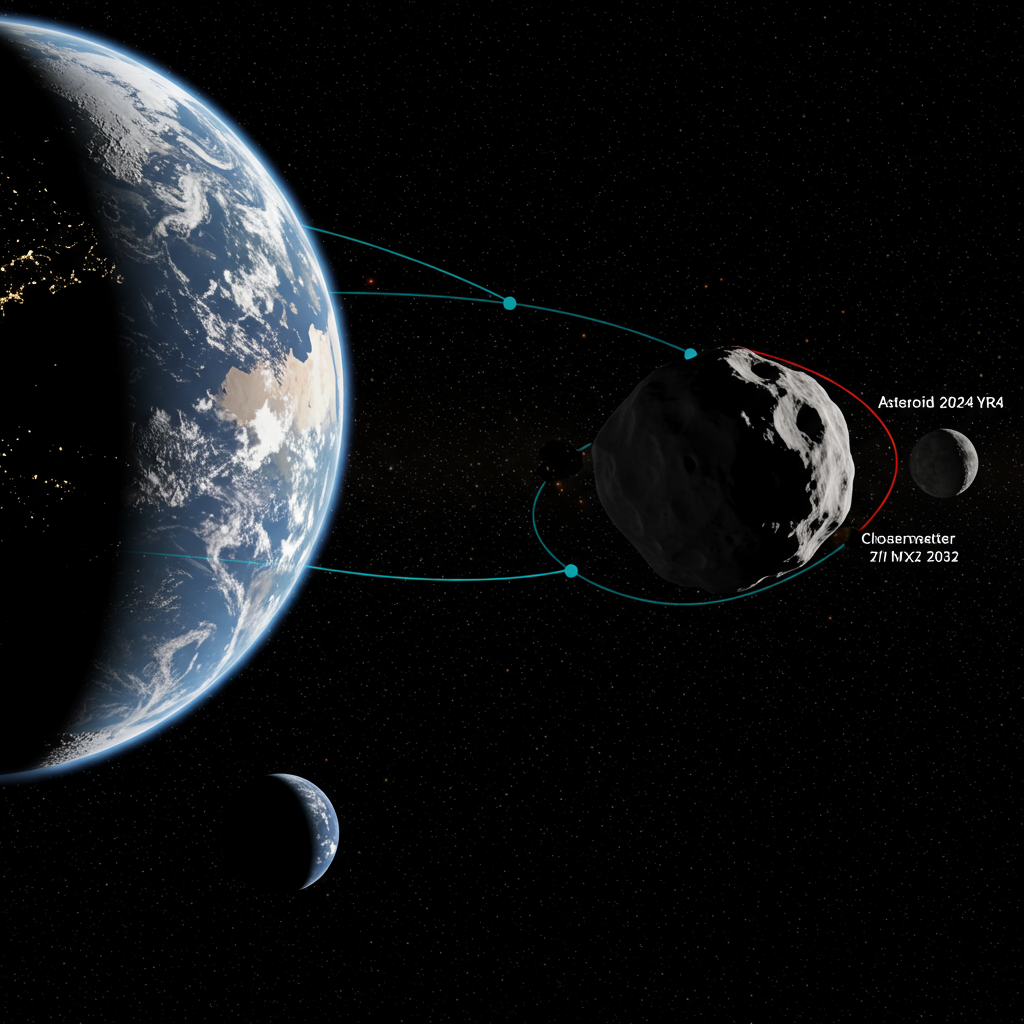An awe-inspiring cosmic photograph has captured the enigmatic interstellar comet 3I/ATLAS displaying its spectacular multiple tails as it appears to “photobomb” a distant galaxy. This remarkable image not only offers a rare glimpse into the complex structure of a celestial visitor from beyond our solar system but also serves as a vivid reminder of its truly otherworldly, yet perfectly natural, origins. The striking visual underscores why scientists are intensely studying this unique object to unlock secrets about the universe’s earliest days.
The Cosmic Encounter: A Breathtaking Snapshot
Astrophotographer Satoru Murata, based in New Mexico, recently unveiled a stunning image of the interstellar comet 3I/ATLAS. Captured on November 16th, shortly before sunrise, using a 0.2-meter telescope, the photograph showcases the comet’s vivid green glow emanating from its coma. It distinctly features the comet’s elongated ion tail, the reemergence of a shorter anti-tail, and several smaller jets of gas bursting from its icy core. Adding to the visual drama, the barred spiral galaxy NGC 4691, located approximately 70 million light-years away, can be seen majestically in the top left of the frame. This dramatic juxtaposition evokes a profound sense of the comet’s immense journey from deep space.
Murata, who has a background in astronomical research, shared that seeing the comet alongside NGC 4691 truly created “the impression of the object being from another world.” However, he is quick to clarify that while “from another world” is a fitting description, it refers to its interstellar provenance, not an extraterrestrial construction.
Unraveling the Comet’s Enigmas: Tails, Jets, and Ancient Secrets
The captivating display of 3I/ATLAS’s multiple tails and jets is a direct result of intricate cometary processes. The long ion tail consists of gases ionized by solar radiation, always pointing directly away from the sun. The shorter, reemerging anti-tail is believed to be caused by excess dust particles blowing off the comet’s surface. Interestingly, the comet had temporarily appeared to lose both these tails in recent weeks, a phenomenon later attributed to an optical illusion based on its relative position to Earth.
Furthermore, smaller jets observed erupting from the comet’s coma are evidence of “outgassing.” This natural process occurs when solar radiation heats the comet’s icy interior, causing trapped gases to expand and shoot out through cracks in its frozen crust. This outgassing provides a subtle, non-gravitational acceleration to the comet. It was also the basis for a recent, swiftly debunked rumor that 3I/ATLAS had exploded, highlighting the often-misunderstood dynamics of these ancient wanderers.
New insights from recent observations indicate that 3I/ATLAS is unusually rich in carbon dioxide. Its surface may also possess a thick, irradiated crust, a consequence of billions of years of exposure to cosmic rays in interstellar space. Understanding these chemical and physical properties is crucial for scientists. They hope to gain unprecedented insights into the conditions around other stars and the pristine material present in the early galaxy.
A Visitor from Beyond Our Sun: An Interstellar Odyssey
Comet 3I/ATLAS holds a special place in astronomical history as only the third interstellar object ever discovered within our solar system. First spotted in early July, this celestial nomad is hurtling towards the sun at an astonishing speed of over 130,000 mph (210,000 km/h). Scientists hypothesize that it originates from the “frontier” region of our Milky Way galaxy. Its age is particularly remarkable; estimations suggest 3I/ATLAS could be up to 7 billion years old, making it significantly older than our solar system itself.
Its recent journey around the sun was anything but uneventful. After reaching its closest point to our home star on October 29th, the comet reemerged from behind the sun’s far side, relative to Earth. During this perilous pass, 3I/ATLAS experienced an unexpected brightening event and a temporary color change, alongside displaying several other anomalous characteristics. These traits underscore its unique nature compared to comets that originated within our solar system.
It’s important to distinguish 3I/ATLAS from other comets sharing a similar name. For instance, Comet C/2025 K1 (ATLAS), sometimes called the “other comet ATLAS,” recently fragmented into multiple pieces after its own close approach to the sun. While both were discovered by the ATLAS survey network, their origins and behaviors are distinct, with 3I/ATLAS retaining its integrity and continuing its journey.
Debunking the “Alien Spaceship” Theory
The unusual characteristics and interstellar origin of 3I/ATLAS have, inevitably, fueled speculative theories. A few researchers have controversially proposed the possibility that 3I/ATLAS might be an alien spaceship disguised as a comet. This echoes similar claims made about ‘Oumuamua, the first interstellar object discovered in 2017, which is now widely believed to be an asteroid.
However, the overwhelming majority of the astronomical community firmly believes that 3I/ATLAS is, almost certainly, a comet. Photographer Satoru Murata, echoing this scientific consensus, emphatically dismissed the alien hypothesis in his social media posts. “No, it’s not an alien mothership,” he stated, adding that “the probability that it’s any type of object created by extraterrestrial civilization is close to zero.” His perspective aligns with the scientific principle: “if it looks like a duck and behaves like a duck, it’s a duck.” Studying these objects for their natural scientific value provides far more profound insights than unverified speculation.
Anticipating Future Revelations from 3I/ATLAS
The scientific community eagerly awaits further high-definition observations of 3I/ATLAS. NASA is scheduled to release an unprecedented collection of images captured by its Mars Reconnaissance Orbiter on November 19th. These images, taken during the comet’s close flyby of the Red Planet on October 3rd, are expected to surpass even the clarity and detail offered by the Hubble Space Telescope. Their release was delayed due to a recent government shutdown.
Additionally, the European Space Agency (ESA) announced on November 14th that its ExoMars Trace Gas Orbiter has provided crucial data. This information has helped researchers refine 3I/ATLAS’s predicted trajectory through our solar system tenfold, enabling more accurate future observations. These combined efforts are part of a broader scientific endeavor to precisely map the interstellar visitor’s path and gather as much data as possible before it departs.
3I/ATLAS is slated to make its closest approach to Earth on December 19th. At this time, it will pass at a minimum distance of 168 million miles (270 million km) from our planet. While too distant for naked-eye viewing, this close encounter presents a final, valuable window for detailed scientific scrutiny, before the 7-mile (11 km) wide cosmic traveler continues its journey back into the vastness of interstellar space.
Frequently Asked Questions
What makes Comet 3I/ATLAS an interstellar object and why is it so important to study?
Comet 3I/ATLAS is designated as an “interstellar object” because its trajectory indicates it did not originate within our solar system, but rather from another star system in the Milky Way. It is only the third such object ever discovered. Its extreme age, estimated at up to 7 billion years, makes it potentially older than our sun. Studying 3I/ATLAS provides a rare opportunity to analyze pristine material from outside our cosmic neighborhood, offering unparalleled insights into the chemical compositions of other star systems, the conditions in the early galaxy, and the dynamics of objects traveling through interstellar space.
How do astronomers track and observe distant objects like Comet 3I/ATLAS?
Astronomers employ a combination of ground-based telescopes, space-based observatories, and advanced computational models to track and observe objects like 3I/ATLAS. Initial discovery often comes from wide-field sky surveys, like the ATLAS system itself. Subsequent observations involve powerful telescopes (like the one used by Satoru Murata, or even the Hubble Space Telescope) to capture detailed images and spectral data. Spacecraft, such as NASA’s Mars Reconnaissance Orbiter and ESA’s ExoMars Trace Gas Orbiter, can provide unique close-up perspectives and data for refining trajectories, which is crucial for predicting future movements and optimizing observation campaigns.
Has the mystery of 3I/ATLAS’s “alien” nature been resolved, and when can we expect new observations?
Yes, the scientific consensus firmly establishes 3I/ATLAS as a natural comet, not an alien spaceship. While its “otherworldly” origin from beyond our solar system is genuinely fascinating, astronomers have found no evidence supporting an artificial construct. Its behaviors, such as outgassing and developing tails, are consistent with known cometary physics. The most anticipated new observations will come from NASA, which is scheduled to release high-definition images captured by its Mars Reconnaissance Orbiter on November 19th. These images are expected to provide the clearest views of 3I/ATLAS to date, further aiding scientific understanding.
Conclusion
The stunning new photograph of interstellar comet 3I/ATLAS serves as a powerful reminder of the universe’s boundless wonders. This multi-tailed visitor, briefly gracing our solar system before its return to interstellar space, embodies both mystery and scientific opportunity. Far from being an alien construct, 3I/ATLAS is a natural relic from a distant past, carrying clues about the formation of other stars and the chemical tapestry of our galaxy. As astronomers continue to analyze its secrets, this cosmic encounter enriches our understanding of the universe, inspiring awe and pushing the boundaries of human knowledge.



